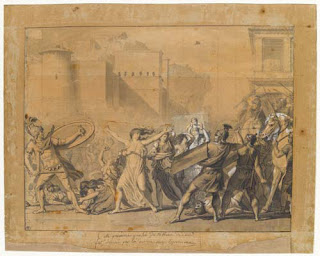 |
| Jacques-Louis David, Sketch for Intervention of the Sabine Women in the Fight Between the Sabines and the Romans French, 1798-1799 Drawing (graphite, pen and black ink on paper) Paris, Louvre |
In these two exhibitions we can chart the threads of artistic expression that carried art in France from the end of the Rococo era, just prior to the French Revolution, through the Neo-Classical phase, which ran concurrently with the Revolution and the First French Empire (Napoleon), and into the Romantic era, with its focus on the exotic, the emotional and the natural world. Indeed, it can be argued that the Neo-Classical style is simply another form of the predominant Romanticism of the period, a different mode of the exotic.
Viewing the drawings from the Louvre is like taking a walk through the history of early 19th century French art. All the important artists, and many of the lesser known, are included: David, Gerard, Gericault, Girodet, Granet, Gros, Ingres. But the most revealing are the many drawings by Delacroix that are included.
 |
| Eugene Delacroix, Study for Liberty Leading the People, French, 1830 Drawing, Graphite with chalk on paper Paris, Louvre |
Eugene Delacroix is, par excellence, the artist of the Romantic era. His paintings of exotic scenes, based on his travels in North Africa, his portrayal of scenes charged with violence and strong emotions made him the acknowledged leader of the Romantic painters and one of the most influential painters in Europe.
But the really astonishing drawings are of pure motion, the first such drawings I have ever seen outside of the studies of whirlpools and clouds by Leonardo da Vinci. But, whereas the Leonardo drawings examine natural forces, Delacroix’ are focused on human activity.
 |
| Delacroix, Study for The Death of Sardanapalus French, 1826-1827 Drawing, Pen, brown ink, brown wash on paper Paris, Louvre |
If Delacroix was the leader of those Romantic whose mode was centered on the “sublime”, Jean-Auguste-Dominique Ingres was the leader of the other wing, the Neo-Classicists. Characterized by calm, clear-edged lines and compositions, the Neo-Classicists took their subjects from both contemporary life and the distant past. Thus, the accompanying exhibition of Ingres’ drawings, taken from the Morgan’s own collection is an interesting supplement to the main exhibition.
 |
| Jean-Dominique Ingres, Frau Reinhold and Her Daughters French, 1815 Drawing, Graphite on paper New York, Morgan Library |
The Ingres exhibition will run until November 27th. The exhibition from the Louvre runs throughout the Christmas season, ending on New Year’s Eve. If you’re in the New York area during the season, I urge you to take a break from the shopping or sightseeing and visit them.
* For more information about this exhibition see: http://www.themorgan.org/exhibitions/exhibition.asp?id=49
© M. Duffy, 2011
No comments:
Post a Comment